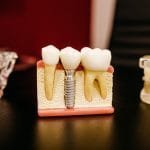A dental bridge is one of the ways a dentist can replace broken or damaged teeth. Depending on the condition of your other teeth and the circumstances that caused the damage, a dentist may recommend a dental bridge to restore your smile.
What Is a Dental Bridge?
A dental bridge is a dental restoration used to replace one or multiple missing teeth. It is essentially a “bridge” created by placing two or more artificial teeth, known as pontics, between two dental crowns. Dentists place the two dental crowns on the adjacent teeth, known as abutment teeth, which serve as anchors for the bridge. The bridge is then cemented into place, creating a permanent and durable restoration that restores the patient’s smile.
Dental bridges are typically made from porcelain, metal, or a combination of both materials. Porcelain is often the preferred material, as it closely imitates the look and feel of natural teeth. The dentist may recommend a metal-based bridge depending on the patient’s situation and budget. In some cases, the dentist may suggest a resin-bonded bridge, an affordable option that uses metal wings to attach the bridge to the abutment teeth.
When Is a Dental Bridge Appropriate?
Dentists typically recommend dental bridges when one or more teeth are missing, and the patient desires a permanent restoration. Dental bridges are more appropriate than crowns or fillings when the patient has multiple teeth missing in a row, as a bridge can span the gap. Dental bridges can also correct a misaligned bite, prevent the remaining teeth from shifting out of place, and restore the patient’s ability to chew and speak properly.
How Do Dentists Install Dental Bridges?
Installing a dental bridge typically begins with the dentist preparing the abutment teeth, which are the teeth adjacent to the gap. The dentist will use a dental drill to extract a portion of the enamel from the abutment teeth to accommodate the bridge. Next, the dentist will create an impression of the prepared abutment teeth and the gap between them. Dentists will use this impression to create a custom bridge in a dental laboratory.
Once the bridge is complete, the dentist will attach the bridge to the abutment teeth with permanent dental cement. The dentist may also use a dental laser to make necessary adjustments to the bridge. After the bridge is in place, the dentist will check the fit and make necessary adjustments. The patient may need to return for a follow-up visit to ensure that the bridge fits properly.
How Long Is the Recovery Process from a Dental Bridge Procedure?
The recovery process from a dental bridge procedure typically takes several days. After the procedure, it is normal for the gums to be sore and tender for a few days. To reduce discomfort, the dentist may recommend taking over-the-counter pain medication. The patient should also avoid eating hard or sticky foods during recovery.
It is also essential to practice good oral hygiene during the recovery period. The patient should brush and floss regularly to reduce the risk of infection. The dentist may also recommend using a special floss threader to clean around the bridge.
The patient should also attend follow-up appointments with the dentist to ensure that the bridge is fitting correctly and that there are no signs of infection. A dental bridge can last long with proper care and maintenance.
Conclusion
Dental bridges are an effective and affordable way to replace missing teeth and restore the appearance of a smile. With proper care and maintenance, a dental bridge can last many years and provide a natural-looking result. If you are considering a dental bridge, speak to your dentist to discuss your options and determine if it is the best treatment.
Leesburg Bright Dental is a trusted dentist in Leesburg, VA. We offer services in dental bridges, fillings, root canal treatments, and more. Contact us today to set an appointment.



